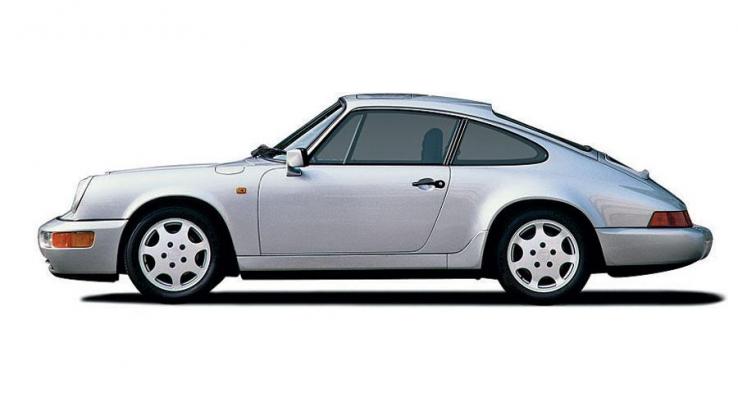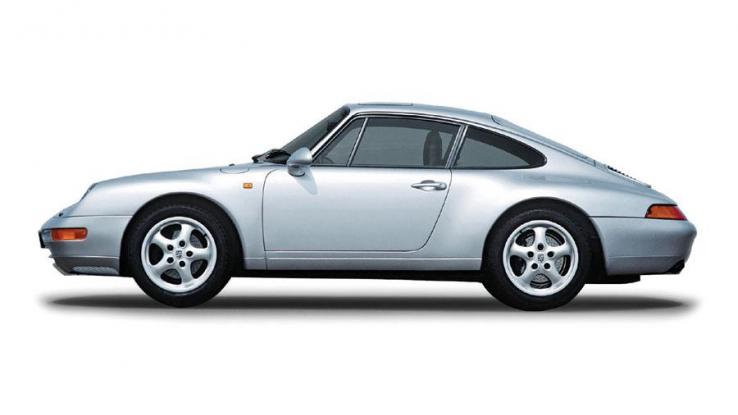Porsche 911 Evolved!

G-Series
The Porsche 911, perhaps more than any other modern car, is clearly a lineal descendant of its original forebear. While today’s Porsche 991 is both bigger and exponentially more sophisticated than the original 901 that bowed at the 1963 Frankfurt motor show, the newest 911 is simply the latest evolution of an enduring era.
The first 911 was an evolution of the Volkswagen-derived Porsche 356. Conceived as a bigger four-seat 356, the 911 became an all-new car featuring a new chassis with MacPherson struts, semi-trailing arms and torsion bar springs, and a brand-new air-cooled, OHC flat-six, initially making 128 hp from 1,991cc. The styling was the work of Ferdinand Alexander “Butzi” Porsche. It echoed the 356’s familiar fastback silhouette, but it turned out to be a timeless design. Central to its character was the fact that the 911 demanded an expert touch from its driver. The short wheelbase, rear-weight bias and semi-trailing arm rear suspension made it easy to break the tail loose. Porsche made various attempts to mitigate that behavior, including an inelegant set of front “bumper reinforcement” weights and a modest wheelbase stretch. But the 911’s defiant tail was not fully tamed until the ’90s.

964 generation
The 911’s wheelbase grew from 87.1 to 89.4 inches in 1969, and its overall length increased about 4.5 inches in 1974 with the addition of bigger 5-mph bumpers. But it remained a very compact car. Mechanical fuel injection was introduced in 1969, became standard in 1974 and gave way to Bosch digital engine management in 1984. Lower compression ratios kept a lid on peak horsepower throughout the ’70s, but performance remained fairly consistent thanks to a series of displacement increases. Starting in 1975, there was also the fearsome 930 Turbo, initially making 260 hp DIN from 2,994cc. The Turbo disappeared from the U.S. in 1980, and by mid-decade, normally aspirated cars could be ordered with the 930’s wide-fendered body and “whale-tail” spoiler. The 930 returned to the U.S. in 1986 with 282 hp.

993 generation
In 1989, Porsche introduced the much-revised 964-generation car, with tidied-up aerodynamics, a retractable rear wing, ABS, power steering, a new suspension with coil springs instead of torsion bars and an updated 3,600cc engine with 247 hp. After decades of styling stasis, the 964 brought a more minimalist silhouette and a somewhat more modern interior layout to Porsche’s signature model. It was also the beginning of the end for the mechanically dead-simple 911. The first 964 was the Carrera 4, with an all-wheel-drive system that decisively addressed the 911’s tail-out antics, though at some cost in sharpness. A rear-wheel-drive Carrera 2 followed in 1990, adding an optional four-speed Tiptronic automatic. The 964 Turbo arrived for 1991, initially with a 315-hp 3,299cc engine; a 355-hp Turbo 3.6 followed in 1993.

996 generation
In 1994, the 964 was replaced by the 993, the final air-cooled 911, sporting an extensive facelift, more power and a choice of six-speed manual or Tiptronic. The biggest change was a new multilink rear suspension that finally laid to rest most of the RWD 911’s nasty habits. The Carrera 4 also returned with a simplified, lighter AWD system. The 993 Turbo arrived in 1995, featuring AWD and 400 hp. The new Turbo was shatteringly quick. But while the Turbo was a little insane, the first 911 GT2 was positively bonkers. Fifty-seven were built as homologation specials so that 993-generation cars could compete in GT2-class racing. The earliest GT2s carried air-cooled, 3.6 liter twin-turbo flat-sixes making 430 hp, though after ’98 the motor made 450 hp. The GT2 was capable of sub-four-second 0-60 sprints.

997 generation
In September 1997, Porsche introduced the first water-cooled 911, the 996. It was still a rear-engined 2+2, but it had close ties to the mid-engined Boxster, using a 3,387cc derivative of its 24-valve “Wasserboxer” with 296 hp. The 996 was the first 911 to have been totally redesigned. In addition to the water-cooled engine, the body and interior were almost entirely new. The “fried-egg” headlights of the early 996 were deemed too similar to those of the lower-priced Boxster and were changed for the 2002 model year. The 996-generation spawned 16 variants, with the Turbo S, GT3, GT3 RS and GT2 taking the performance of street-going 911s to new heights. The AWD Turbo S and RWD GT2 laid claim to the gaudiest numbers, but the naturally aspirated GT3 and GT3 RS took over the track-focused mantle.

991 generation
The evolutionary 997 followed for 2005 and went on to become the best-selling generation of 911 yet. Porsche traditionalists lauded the return to round headlights, and a better interior brought the 911 more in line with the other high-priced sports cars. Performance for the 997 was staggering: The 911 Turbo S was capable of 0-60 runs of less than three seconds. The 997-generation cars were the first 911s to make use of the new PDK semiautomatic transmission. As the Nürburgring Nord-schleife production car lap-time record became a source of bragging rights, Porsche watched Dodge and Nissan set unbelievable times with their GT-R and Viper ACR. So, Porsche began development of the 911 GT2 RS, which set a time of 7:18, taking the record, if only momentarily.

The 991 arrived in 2012 with a sleeker profile, a longer wheelbase and the choice of rear-wheel drive or all-wheel drive, and normally aspirated or twin-turbo engines. It is larger and more refined than the outgoing 997, but it’s also lighter and more powerful. There are some who insist the water-cooled models are not real 911s. However, the 911 has survived because it evolves. Porsche has considered replacing the 911, but each time it has recognized that doing so would be foolhardy. If you say “Porsche,” people still assume you mean the 911. The car represents tangible reassurance that Porsche hasn’t lost touch with its roots even as the company expands into new arenas. For that reason alone, the 911 is likely to continue for as long as Porsche does.

Leave a Reply
Want to join the discussion?Feel free to contribute!